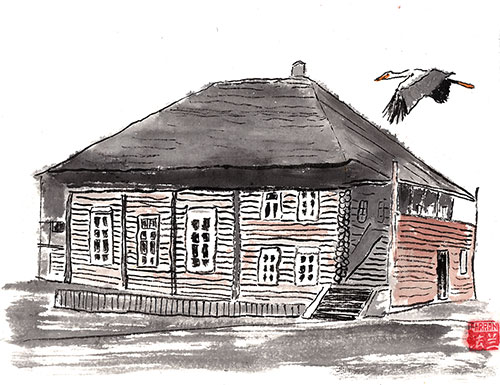Lost Treasures: The Wooden Synagogues of Eastern Europe The Artwork of Bill Farran
Zhlodin, Belarus - Sumi-e Style Brush Painting
Zhlodin, Belarus - Sumi-e Style Brush Painting
Yiddish: Zhlodin
Polish: Zlobin
Zhlodin was first mentioned in the 15th century. Sources mention the presence of Jews in the village since the 17th century. It is known that in the 1760’s a Jewish pogrom was staged in the city by hidamaks (Ukrainian paramilitary outfits composed of commoners (peasants, craftsmen and improvised Ukrainian nobleman)
In 1793, the settlement became part of the Russian Empire. This contributed to the growth of the Jewish population. . In 1873 the Libau-Romny railway passed through the town and boosted the town’s growth. The railroad connected Romny Ukraine with the ice-free port in Libau, on the Baltic Sea in present-day Latvia. By the 1880’s, the Jewish population of Zhlobin reached its peak. Jews owned over 50% of the houses in the city. They made up 82.2% of the total population. There were five synagogues in the city.
By the time Zhlobin was captured by the Nazi in August 1941, many Jews had a chance to evacuate. Those who were left behind were forced into two tiny ghettos. Jewish community of Zhlobin was destroyed in April 1942
Purchase a print
Sumi-e Style Brush Prints are 8x10 inches, in an 11x14 matte.
